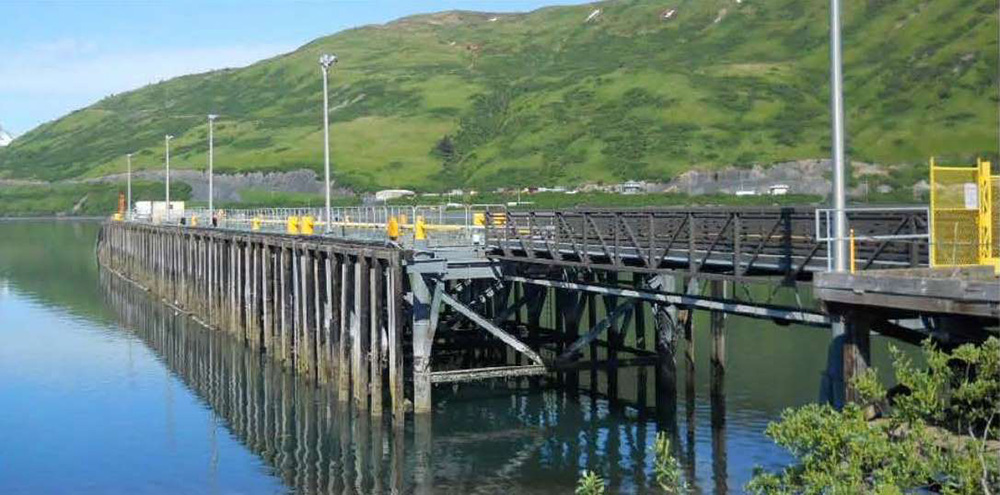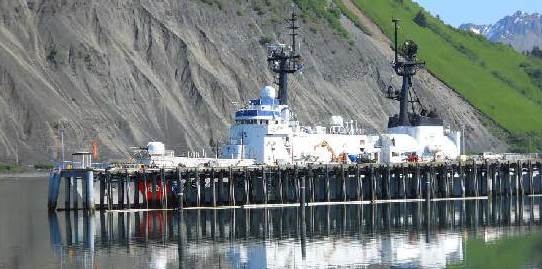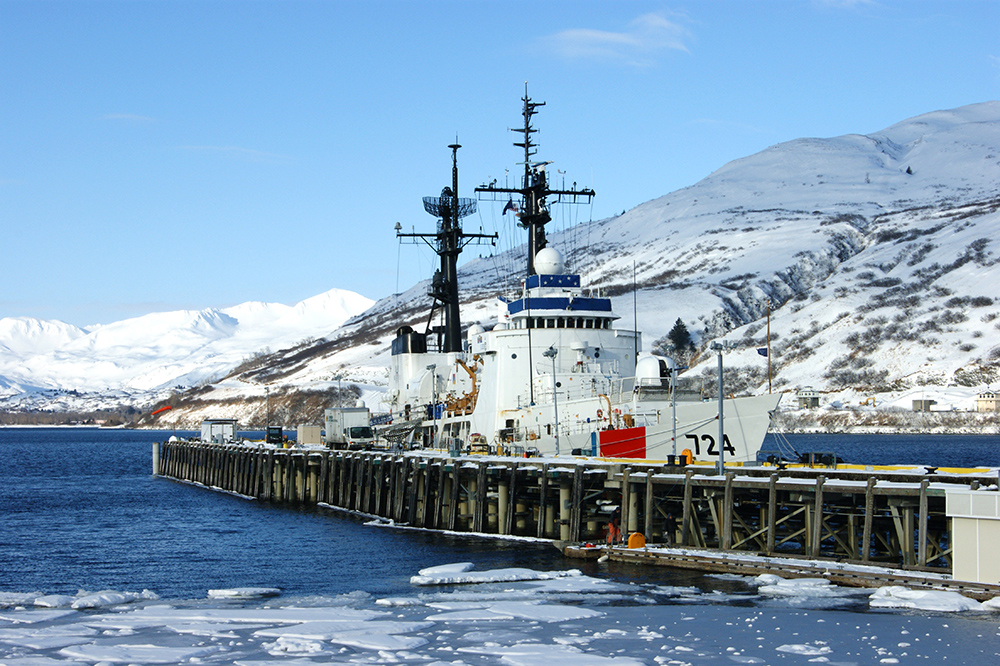I recently had the opportunity to work with the U.S. Coast Guard to help them come up with a solution for repairing and upgrading components of their fuel pier and cargo wharf in Kodiak, Alaska, that ultimately helped them save over $37 million.
A Little Background
Integrated Support Command (ISC) Kodiak is the United States Coast Guard’s largest operating base. Located in Kodiak, Alaska, the ISC is homeport to the vessels USCGC SPAR (WLB-206), USCGC MUNRO (WEHEC-724), and USCGC ALEX HALEY (WMEC-39). Two aging structures at the base, the Fuel Pier and Cargo Wharf, were in need of upgrades and repairs.

The 603-foot Fuel Pier was constructed in 1940 using steel H-piles and wood piles supporting wood beams, stringers, and decking and has received multiple retrofits since then. Among the most notable retrofits were a 1965 project to raise the pier 6 feet after the 1964 earthquake lowered the coastline and a 2010 project to overhaul the pier structure and extend its useful life. In addition to refueling cutters, the Fuel Pier is the off-load point for deliveries of fuel oil and aircraft fuel. The Fuel Pier is also used for minor vessel logistics, such as loading of supplies that can be delivered by a flatbed truck. The Fuel Pier is not capable of crane loading so heavier vessel-logistics services are done at the Cargo Wharf.

The northern end of the Cargo Wharf was constructed in 1967 and rehabilitated in 1990. In 1986, the southern end of the Wharf was extended to provide increased berthing space. The piles are steel H-piles protected by a cathodic protection system. The framing and decking are constructed of reinforced concrete. In 2008, an approximate 30 percent loss of steel cross section was found in several H-piles. Based on the findings, the wharf structure had limited lateral load capacity.
The three cutters currently homeported in Kodiak will remain homeported there. Deepwater assets which include, two Offshore Patrol Cutters (OPC) and National Security Cutters (NSC) have visited Kodiak since 2011, however, due to the limited capacity of the dock and the existing fender system, they have only been able to berth/moor for a short period of time. The upgrades and repairs will allow the deep water assets to be homeported at Kodiak.
The Fuel Pier and Cargo Wharf facilities do not have sufficient lateral capacities for berthing and mooring of the deepwater assets. Furthermore, the NSC has a prominent hull shape which has damaged the existing fender systems. Overall, the existing fender system has not been providing the proper protection for either the facilities or the vessels.
Food, Animals, or Marine Equipment?
In the marine/waterfront industry several devices, equipment, and structures have interesting names. You could easily confuse them with your favorite food or an animal. Before I start discussing the project tasks, I’ll give you a few of the more interesting ones.
- Camel – A device used between the ship and the pier (or wharf) or between the nested ships.
- Dolphin – A discrete structure designed primarily to accommodate the lateral forces associated with vessel berthing and mooring.
- Sausage – This is a nickname for a pneumatic or foam-filled fender.
- Donut – This is a nickname for a vertical foam-filled fender guided by a mono pile.
Need for an Affordable Solution
Several years ago, a Seattle-based engineering consulting firm recommended replacement of the entire Fuel Pier facility. Their Planning Proposal for Recapitalization of the Fuel Pier estimated the total capital cost would be about $47 Million. Unfortunately, that high cost made replacement of the Pier unfeasible. The USCG and Reid Middleton strongly believed that effective use and operation of both the Fuel Pier and Cargo Wharf for loading, unloading, and fueling could extend the life and usage of both facilities with a lot less cost. Focusing on developing a high-performance, cost-effective, and affordable solution for upgrading both facilities, we came up with a solution dedicating the Cargo Wharf to heavier vessel-logistics services and the Fuel Pier to temporary vessel berthing and fueling. The new design, consisting of new dolphins, fender system upgrades, and localized repair, replacement, or upgrade of structural components enabled the Coast Guard to save more than $37 Million.
Task 1: Fuel Pier Upgrade
The Fuel Pier’s existing steel-framed structure has been upgraded to improve efficiency of fueling, safety, and accessibility for vessel berthing. The upgrade included filling two large open spaces to enhance accessibility for service vehicles, replacement of the damaged timber fender piles, replacement of log camels with new large-diameter HDPE camels, and installation of a new fire-protection dry pipe system at the head of the Pier. The north berth, equipped with the new camels, will accommodate vessels with a significant hull sweep, such as the NSC (National Security Cutter), the USCGC Munro (High Endurance Cutter), the USCGC Alex Haley (Medium Endurance Cutter), and the OPC (Offshore Patrol Cutter). The south berth will have continuous camels and fender systems to accommodate small-sized Coast Guard vessels and barges.
Task 2: Cargo Wharf Camel Replacement and Fender Repair
The Cargo Wharf’s existing timber fender system had been damaged by significant hull sweep. To avoid further damage before construction of the permanent solution, several foam-filled fenders have been temporarily inserted between the fender piles and critical locations of ship hulls. Installation of the new durable continuous HDPE camels and fender repair will improve berthing and operation safety for large Coast Guard vessels having significant hull sweep, such as the NSC, the USCGC Munro, the USCGC Alex Haley, and the OPC.
Task 3: Fuel Pier Recapitalization Planning
Reid Middleton provided engineering services for revision of the existing planning proposal evaluating Fuel Pier recapitalization alternatives to meet requirements for current and future operational and support functions. The key element of the plan is enhancement of lateral load resistance of the pier against earthquake and ship berthing. Reid Middleton developed a cost-effective concept design of the new continuous breasting dolphin system along the north side of the pier to enhance lateral load resistance capacity.
Task 4: Cargo Wharf Upgrade Planning
Considerations similar to the Fuel Pier were encountered at the Cargo Wharf. The 46-year-old Cargo Wharf does not have enough lateral load resistance against earthquakes or ship berthing. A continuous breasting dolphin system was also applied along the north berth of the wharf to improve lateral load resistance and berthing safety for current and future Coast Guard vessels with significant hull sweep. In addition to improvement of lateral load resistance, the upgrade design includes a dock extension at the northeast end to improve operation of USCGC Spar Buoy Tender and upgrade of the fender system. The facility upgrade will improve long-term serviceability and operational and berthing safety for current and future vessels and require minimal maintenance.
Conclusion
The Cargo Wharf and Fuel Pier upgrades are under construction, and the first phase of construction is slated to be completed by fall of 2014. Reid Middleton serves as the prime consultant on over 80 percent of our waterfront projects, and over 85 percent of the contracts are with governmental agencies, including over 20 projects with the U.S. Coast Guard.


